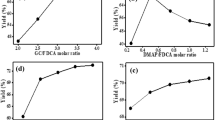Abstract
A vinyl ether containing a five-membered cyclic carbonate group, 2-(2-vinyloxyethoxy)ethyl carbonate (VEECN), was synthesized by adding CO2 to 2-(2-vinyloxyethoxy)ethyl glycidyl ether, which is a vinyl ether containing an epoxy group. Cationic polymerization of VEECN was performed in nitromethane at − 30 °C with boron trifluoride etherate. The resulting poly(VEECN) exhibited a number-average molecular weight of ~ 3500 g/mol and a molecular weight distribution of ~ 1.40. Poly[2-(2-vinyloxyethoxy)ethyl hydroxyurethane]s [poly(VEEHU)-C2 to -C5] were synthesized by reacting the cyclic carbonates in the side chains of the obtained poly(VEECN) with four alkanolamines with different methylene numbers (2–5) to form hydroxyurethane groups. The reaction ratios were adjusted to approximately 50%, 75%, and 100%, and the thermal responses and properties of poly(VEEHU)-C2 to -C5 were investigated. When the urethanization ratio was ~ 50%, the cloud points (Tcp) of 1% w/v poly(VEEHU)-C3 to -C5 aqueous solutions were observed at 46, 27, and 8 °C, respectively, with the temperature decreasing with increasing methylene number. Conversely, the poly(VEEHU)-C2 aqueous solution did not exhibit a Tcp at ≤ 95 °C. The glass transition temperatures of the polymers were − 32 °C for poly(VEECN) and − 28, − 32, − 33, and − 35 °C for poly(VEEHU)-C2 to -C5, respectively. Additionally, the thermal decomposition temperatures of the polymers were 279 °C for poly(VEECN) and 253–262 °C for poly(VEEHU)-C2 to -C5, indicating that poly(VEEHU) were flexible polymers at room temperature with relatively high thermal stabilities.







Similar content being viewed by others
References
Kennedy JP, Maréchal E (1982), Chapter 3. In: Carbocationic polymerization. Wiley. New York
Sawamoto M (1991) Modern cationic vinyl polymerization. Prog Polym Sci 16:111–172. https://doi.org/10.1016/0079-6700(91)90008-9
Aoshima S, Kanaoka S (2009) A renaissance in living cationic polymerization. Chem Rev 109:5245–5287. https://doi.org/10.1021/cr900225g
Aoshima S, Oda H, Kobayashi E (1992) Synthesis of thermally induced phase separating polymer with well-defined polymer structure by living cationic polymerization. I. Synthesis of poly(vinyl ether)s with oxyethylene units in the pendant and its phase separation behavior in aqueous solution. J Polym Sci A Polym Chem 30:2407–2413. https://doi.org/10.1002/pola.1992.080301115
Sawamoto M, Aoshima S, Higashimura T (1988) Synthesis of new functional polymers by living cationic polymerization. Makromol Chem Macromol Symp 13–14:513–526. https://doi.org/10.1002/masy.19880130137
Feit B-A, Halak B (2002) Living cationic polymerization route to poly(oligooxyethylene carbonate) vinyl ethers. J Polym Sci A Polym Chem 40:2171–2183. https://doi.org/10.1002/pola.10294
Chernykh A, Alam S, Jayasooriya A, Bahr J, Chisholm BJ (2013) Living carbocationic polymerization of a vinyl ether monomer derived from soybean oil, 2-(vinyloxy)ethyl soyate. Green Chem 15:1834–1838. https://doi.org/10.1039/C3GC40605A
Namikoshi T, Kaneda A, Miyanaga T, Watanabe S, Murata M (2015) Living cationic polymerization of vinyl ether with a Thienyl Group. Kobunshi Ronbunshu 72:433–439. https://doi.org/10.1295/koron.2014-0089
Namikoshi T, Watanabe Y, Kaneda A, Ishikawa K, Watanabe S, Murata M (2021) Controlled cationic polymerization of sulfide-containing vinyl ethers. Macromol Res. https://doi.org/10.1007/s13233-022-0004-1
Hashimoto T, Ibuki H, Sawamoto M, Higashimura T (1988) Living cationic polymerization of 2-vinyloxyethyl phthalimide: Synthesis of poly(vinyl ether) with pendant primary amino functions. J Polym Sci A Polym Chem 26:3361–3374. https://doi.org/10.1002/pola.1988.080261219
Namikoshi T, Hashimoto T, Kodaira T (2004) Living cationic polymerization of vinyl ethers with a urethane group. J Polym Sci A Polym Chem 42:2960–2972. https://doi.org/10.1002/pola.20145
Nishikubo T, Kameyama A, Sasano M (1994) Synthesis of functional polymers bearing cyclic carbonate groups from (2-Oxo-1,3-dioxolan-4-yl)methyl vinyl ether. J Polym Sci A Polym Chem 32:301–308. https://doi.org/10.1002/pola.1994.080320211
Caló V, Nacci A, Monopoli A, Fanizzi A (2002) Cyclic carbonate formation from carbon dioxide and oxiranes in tetrabutylammonium halides as solvents and catalysts. Org Lett 4:2561–2563. https://doi.org/10.1021/ol026189w
Ke J, Li X, Wang F, Jiang S, Kang M, Wang J, Li Q, Wang Z (2017) Non-isocyanate polyurethane/epoxy hybrid materials with different and controlled architectures prepared from a CO2-sourced monomer and epoxy via an environmentally friendly route. RSC Adv 7:28841–28852. https://doi.org/10.1039/C7RA04215A
Ochiai B, Hatano Y, Endo T (2008) Fixing carbon dioxide concurrently with radical polymerization for utilizing carbon dioxide by low-energy cost. Macromolecules 41:9937–9939. https://doi.org/10.1021/ma801960q
Matsukizono H, Endo T (2018) Reworkable polyhydroxyurethane films with reversible acetal networks obtained from multifunctional six-membered cyclic carbonates. J Am Chem Soc 140:884–887. https://doi.org/10.1021/jacs.7b11824
Dong W, Yoshida Y, Endo T (2021) Synthesis of poly(hydroxyurethane) from 5-membered cyclic carbonate under mild conditions in the presence of bicyclic guanidine and their reaction process. J Polym Sci 59:502–509. https://doi.org/10.1002/pol.20200825
Heskins M, Guillet JE (1968) Solution properties of poly(N-isopropylacrylamide). J Macromol Sci Part A 2:1441–1455. https://doi.org/10.1080/10601326808051910
Iinuma A, Hashimoto T, Urushisaki M, Sakaguchi T (2016) Vinyl ether-based polyacetal polyols with various main-chain structures and polyurethane elastomers prepared therefrom: Synthesis, structure, and functional properties. J Appl Polym Sci 133:44088. https://doi.org/10.1002/app.44088
Acknowledgements
We are grateful to Nippon Carbide Industries for supplying diethylene glycol monovinyl ether.
Funding
The authors did not receive support from any organization for the submitted work.
Author information
Authors and Affiliations
Corresponding authors
Ethics declarations
Conflict of interest
The authors declare no conflicts of interest.
Data availability
The data used to support the findings and results presented herein are available from the corresponding authors upon reasonable request.
Code availability
Not applicable.
Additional information
Publisher's Note
Springer Nature remains neutral with regard to jurisdictional claims in published maps and institutional affiliations.
Supplementary Information
Below is the link to the electronic supplementary material.
Rights and permissions
About this article
Cite this article
Namikoshi, T., Hashimoto, T., Shikano, N. et al. Syntheses of poly(vinyl ether)s containing hydroxyurethanes by reaction of cyclic carbonate with alkanolamines and their characterizations. Polym. Bull. 80, 3689–3701 (2023). https://doi.org/10.1007/s00289-022-04235-w
Received:
Revised:
Accepted:
Published:
Issue Date:
DOI: https://doi.org/10.1007/s00289-022-04235-w



